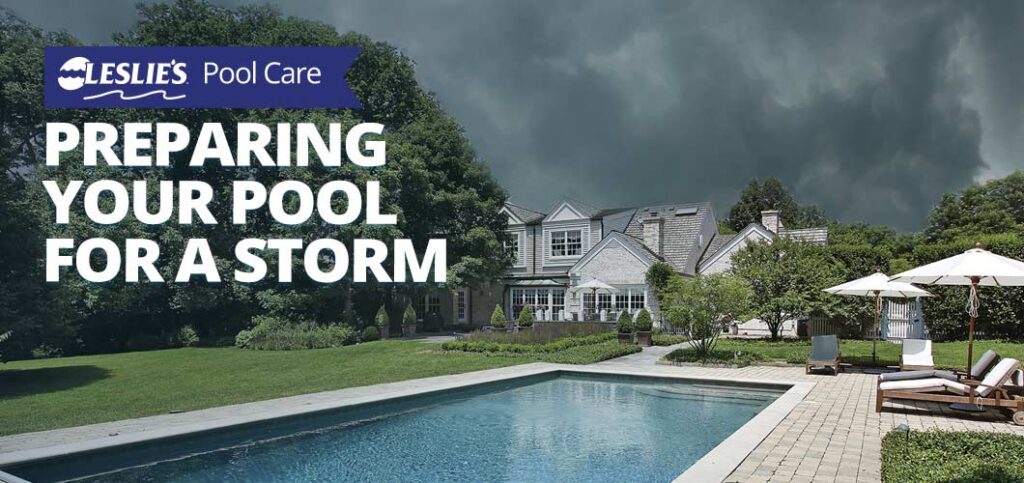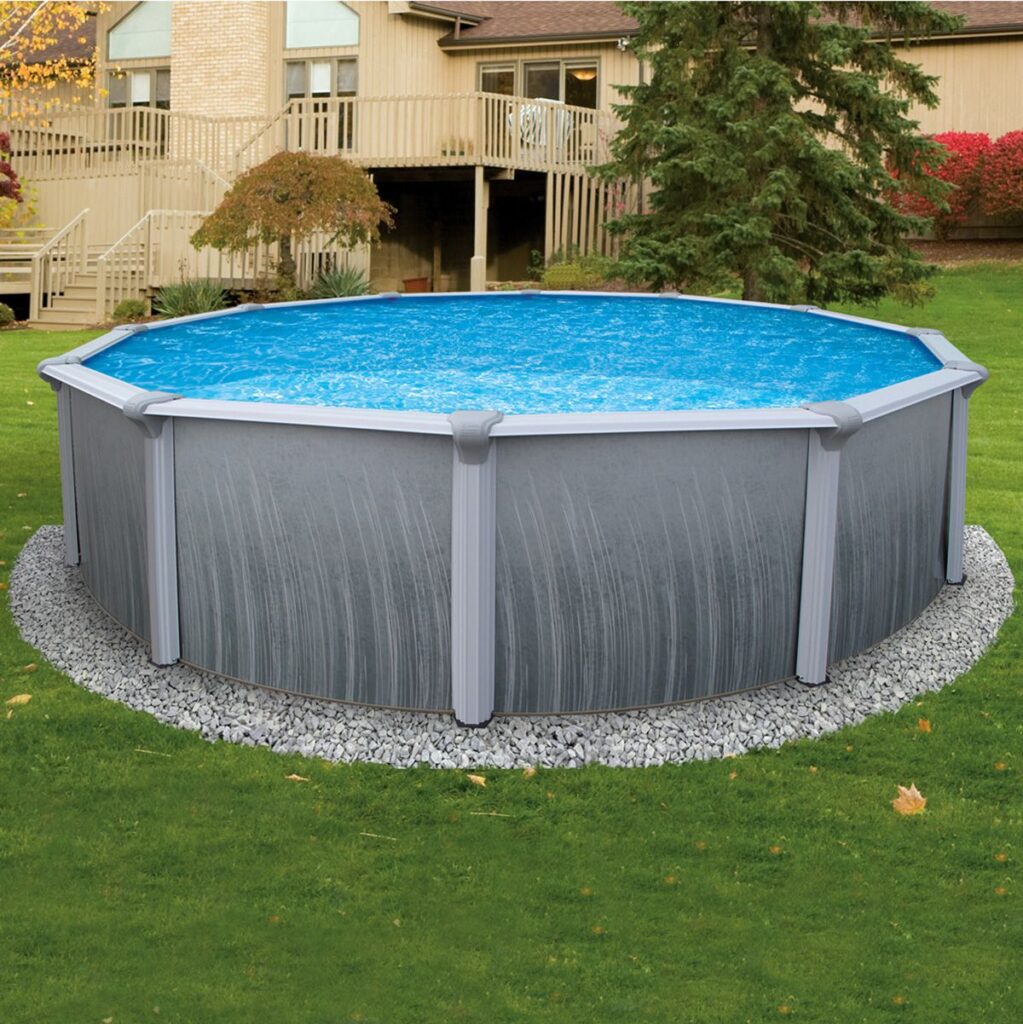You’re enjoying the summer sun, cool breeze, and refreshing dips in your above ground pool. But as much as you love your pool, you also know that severe weather can strike unexpectedly, posing a threat to its safety and durability. In this article, we will provide you with essential tips and tricks on how to prepare your above ground pool for severe weather, so you can protect your investment and continue to enjoy your pool for years to come.
Inspecting and Securing the Pool Area
Checking for any damages or weak points
Before severe weather strikes, it is crucial to inspect your pool area for any damages or weak points that may need immediate attention. Start by examining the pool perimeter for cracks, chips, or any other signs of structural damage. Additionally, check the pool deck and surrounding fence for any loose or damaged components. Repairing these issues beforehand can prevent further damage during a storm and ensure the safety of your pool area.
Securing loose items
In preparation for severe weather, it is important to secure any loose items around the pool area. Strong winds can turn seemingly harmless objects into projectiles, posing a threat to your pool and surrounding structures. Take the time to secure or store items such as pool furniture, toys, floats, and umbrellas. By securing these items, you not only protect them from potential damage but also minimize the risk of them causing damage to the pool or adjacent structures.
Trimming surrounding trees and plants
Overhanging trees and branches near your pool area can pose a significant threat during severe weather. Trim any branches or limbs that hang over the pool, as they can easily break due to high winds and cause damage to the pool structure. Additionally, remove any dead or weak trees that may be at risk of falling during a storm. By properly maintaining the vegetation around your pool, you reduce the chances of debris falling into the water or causing damage to the pool area.
Installing a pool cover
One of the most effective ways to protect your pool during severe weather is by installing a sturdy and properly fitted pool cover. A high-quality pool cover acts as a barrier, preventing debris, leaves, and other objects from entering the pool. It also helps to maintain the chemical balance of the water by reducing the amount of rainwater that enters the pool. Ensure that the cover is securely fastened to withstand strong winds and check for any holes or tears that may need to be repaired before installation. Installing a pool cover not only protects your pool investment but also saves you time and effort in post-storm cleanup.
Preparing the Water
Balancing and stabilizing the pH level
Maintaining the proper pH level of your pool water is essential for its longevity and the well-being of swimmers. Before severe weather hits, test the water’s pH level and adjust it to the recommended range. Use pH stabilizers or adjusters to bring the levels to the appropriate range, usually between 7.4 and 7.6. An imbalanced pH not only affects the efficiency of your pool’s sanitizer but can also lead to corrosion in your pool equipment. By balancing and stabilizing the pH level, you ensure that the water chemistry remains in optimal condition during and after the storm.
Shock treating the water
Shocking your pool water before severe weather helps to eliminate any bacteria or contaminants that may be present. Use a pool shock product following the manufacturer’s instructions. This process will oxidize and sanitize the water, ensuring it remains clean and safe. Shock treating the water before a storm is particularly important as heavy rainfall and debris can introduce additional contaminants to the pool.
Adding algaecide
In preparation for severe weather, add an appropriate amount of algaecide to your pool water. Algaecide helps to prevent the growth of algae, which can quickly proliferate during stormy conditions. A high-quality algaecide will help to keep your water clear and free of unsightly green or black algae blooms. Be sure to follow the instructions on the product label and choose an algaecide that is suitable for your pool type.
Using a pool floater
Before severe weather arrives, consider using a pool floater filled with chlorine tablets. A pool floater will release a small amount of chlorine into the water, helping to maintain the sanitizer level during the storm. This is especially important if there is a power outage, as the lack of filtration and circulation can lead to bacteria growth. A pool floater provides a convenient and effective way to ensure your water remains clear and safe even when faced with inclement weather.
This image is property of blog.lesliespool.com.
Protecting the Pool Structure
Removing any excess water
To prevent potential damage from heavy rainfall, it is essential to remove any excess water from your pool before severe weather hits. Use a submersible pump or a pool cover pump to drain excessive water from your pool. This will not only relieve the pressure on the pool walls but also help to prevent flooding and structural damage. Be sure to follow the manufacturer’s instructions when operating the pump and discharge the water away from your pool area and any nearby structures.
Covering and securing pool equipment
Before severe weather arrives, cover and secure your pool equipment to protect it from potential damage. Use appropriate covers for your filtration system, pump, heater, and any other equipment that is exposed to the elements. Make sure the covers are securely fastened to prevent them from being blown away by strong winds. Additionally, consider removing any detachable items such as baskets or filters and store them in a safe and dry location until the storm has passed.
Draining the pool partially
In certain situations, it may be advisable to partially drain your pool to prevent damage during severe weather. Consult with a professional or pool contractor to determine if this is necessary for your specific pool type and location. Partially draining the pool can help alleviate pressure on the walls and prevent flooding. However, it is crucial to follow the recommended guidelines and local regulations when draining your pool to avoid any potential structural issues.
Reinforcing the pool walls and liner
For added protection, consider reinforcing the pool walls and liner before severe weather strikes. Some pools, especially older ones, may benefit from additional support to withstand the force of high winds or heavy rainfall. Consult a pool contractor or professional for guidance on reinforcing methods that are appropriate for your pool type. Reinforcing the pool walls and liner can help minimize potential damage and ensure the structural integrity of your pool.
Taking Care of Pool Accessories
Removing and storing pool ladder
Before severe weather arrives, remove the pool ladder and store it safely away from the pool area. Pool ladders are particularly susceptible to damage during storms, and leaving them in the pool can cause unnecessary strain on both the ladder and the pool structure. Store the ladder in a dry and secure location to ensure its longevity and prevent potential accidents when the pool is not in use.
Protecting pool toys and floats
To protect your pool toys and floats from damage during severe weather, gather them and store them in a secure location. Pool toys and floats left in the pool or scattered around the pool area can become projectiles and cause damage to your pool or neighboring structures. Ensure that all toys and floats are properly deflated and dry before storage to prevent mold or mildew growth. By keeping your pool toys and floats safely stored, you can prolong their lifespan and keep them ready for use once the storm has passed.
Taking down and storing poolside umbrella
If you have a poolside umbrella, it is essential to take it down and store it before severe weather strikes. Poolside umbrellas are susceptible to strong winds and can be easily damaged or become dangerous projectiles. Remove the umbrella and store it in a dry and secure location until the storm has passed. By properly storing the poolside umbrella, you can protect it from damage and prevent any potential accidents.
Storing pool maintenance tools
To ensure the longevity of your pool maintenance tools, it is essential to store them properly before severe weather hits. Gather all your pool cleaning equipment, including brushes, skimmers, and nets, and store them in a dry and secure location. Leaving these tools exposed to the elements can lead to rusting or damage, affecting their performance and lifespan. By storing your pool maintenance tools safely, you can keep them in optimal condition and ready for use once the storm has ended.
This image is property of blog.toysplash.com.
Creating a Storm Communication Plan
Designating a responsible contact person
During severe weather, communication is crucial, especially if you are not on the premises. Designate a responsible contact person who can act as the main point of communication for any updates, concerns, or emergencies related to your pool. Ensure that this person is easily reachable and informed about the required maintenance and safety protocols for the pool area. Having a designated contact person helps to streamline communication and ensures that any necessary actions are taken promptly.
Preparing an emergency kit
As part of your storm preparedness, assemble an emergency kit specifically tailored for your pool. This kit should include essential items such as a submersible pump, pool cover pump, extra covers, pool testing kits, and necessary maintenance tools. Additionally, include any additional items recommended by a pool contractor or professional specific to your pool type and location. Having an emergency kit readily available allows you to quickly respond to any pool-related emergencies during and after severe weather.
Monitoring weather updates
Staying informed about the weather conditions is essential when preparing your pool for severe weather. Monitor weather updates from reliable sources and stay alert for any warnings or advisories related to your area. Being aware of forthcoming severe weather allows you to take necessary precautions and make informed decisions regarding your pool maintenance and safety. Stay informed and adjust your storm preparedness plan accordingly.
Establishing an evacuation plan
In the event of an extreme storm or other emergency situations, having an evacuation plan in place is crucial for the safety of everyone involved. Establish a clear evacuation plan for your pool area, ensuring that all family members or pool users understand the procedures. Identify a safe location away from the pool where everyone can gather until the severe weather has passed. Communicate the evacuation plan with all individuals involved and practice it regularly to ensure a smooth and efficient evacuation if necessary.
Securing Pool Electricals
Turning off power to pool equipment
To prevent any electrical issues or equipment damage during severe weather, turn off the power supply to your pool equipment. This includes the filtration system, pump, heater, and any other electrical components. By disconnecting the power source, you eliminate the risk of electrical surges or malfunctions that could cause damage or pose a safety hazard. Remember to follow proper electrical safety procedures and consult a professional if you are unsure about turning off the power.
Disconnecting electrical connections
In addition to turning off the power, it is important to disconnect any electrical connections to your pool equipment. Unplug any cords or cables connected to electrical outlets or timers. Make sure these connections are safely stored away from water sources to prevent any potential accidents. By disconnecting electrical connections, you ensure that your pool equipment remains protected and that there is no risk of electrical hazards during the storm.
Storing electronic devices away from water
To prevent damage to electronic devices and potential electrical hazards, store them away from any potential water sources during severe weather. Remove any TVs, radios, or other electronic devices from the pool area and store them in a safe and dry location. Moisture and water damage can cause devices to malfunction or become unsafe, so it is important to keep them away from potentially wet areas. Protecting your electronic devices not only ensures their longevity but also reduces the risk of electrical accidents.
Securing wiring and outlets
Before severe weather arrives, ensure that all wiring and outlets in your pool area are properly secured. Check for any loose or exposed wires and make sure they are repaired or replaced as needed. Additionally, ensure that all outlets are protected with weatherproof covers to prevent water from entering. Securing the wiring and outlets in your pool area reduces the risk of electrical malfunctions or hazards during storms and minimizes potential damage to your pool’s electrical system.
This image is property of www.inyopools.com.
Reinforcing the Pool Fence
Inspecting the strength and stability of the fence
The pool fence serves as a crucial safety feature, especially during severe weather. Before a storm hits, thoroughly inspect the strength and stability of your pool fence. Look for any signs of damage, including loose boards, rusted hinges, or weakened posts. Repair or replace any damaged components to ensure that your pool fence can withstand the force of high winds and protect the pool area from potential hazards.
Repairing damaged sections
If you notice any sections of the pool fence that are damaged, it is important to repair them promptly. Loose or broken segments can compromise the safety and security of your pool area, especially during severe weather. Reinforce or replace damaged sections to maintain the integrity of the fence and minimize the risk of accidents or damage caused by debris.
Applying weather-resistant sealant
To further protect your pool fence from the elements, consider applying a weather-resistant sealant. This helps to prevent water damage, rot, and corrosion, particularly during severe weather conditions. Choose a sealant that is suitable for your fence material and follow the manufacturer’s instructions for application. Applying a weather-resistant sealant helps to prolong the life of your pool fence and ensures its durability during storms.
Adding additional supports if needed
In certain situations, adding additional supports to your pool fence may be necessary to reinforce its strength and stability. Consult with a professional or pool contractor to assess the need for additional supports based on your specific fence type and location. Reinforcing your pool fence with additional supports provides added protection during severe weather, ensuring that it remains intact and able to withstand high winds or flying debris.
Properly Draining and Covering the Pool
Lowering the water level
Before severe weather strikes, consider lowering the water level in your pool to prevent potential damage. Consult a professional or pool contractor for specific guidance on the required water level reduction based on your pool type and location. Lowering the water level can help to alleviate pressure on the pool walls, minimize flooding risks, and stabilize the pool structure during storms. It is important to follow recommended guidelines and local regulations when draining your pool.
Using a winterizing kit
To properly prepare your pool for severe weather, consider using a winterizing kit. Winterizing kits typically include pool chemicals and products designed to prevent algae growth and maintain the integrity of the water during the off-season. Follow the instructions provided in the kit to ensure that your pool is adequately protected and preserved. Additionally, using a winterizing kit can save you time and effort when it comes to reopening your pool after the storm.
Cleaning the pool thoroughly
Before covering your pool, it is crucial to clean it thoroughly to remove any debris, leaves, or contaminants. Use a pool brush or net to remove any visible debris from the water surface and pool walls. Additionally, vacuum the pool to eliminate any dirt or particles that may have settled on the bottom. By cleaning the pool before covering it, you minimize the risk of debris causing damage or becoming trapped under the cover during the storm.
Securing the pool cover tightly
When severe weather is imminent, ensure that your pool cover is securely fastened to prevent it from being dislodged or damaged by strong winds. Choose a high-quality pool cover that is built to withstand inclement weather conditions and follow the manufacturer’s instructions for installation. Securely fasten the cover using appropriate straps or ties, ensuring that it is tightly and evenly stretched across the pool surface. A properly secured pool cover provides effective protection against debris and water accumulation, safeguarding your pool from potential damage.
This image is property of www.gpspoolstore.com.
Preparing for the Aftermath
Clearing debris and fallen branches
Once the severe weather has passed, it is important to clear any debris and fallen branches from the pool area promptly. Remove any leaves, sticks, or other debris that may have accumulated on the pool cover or fallen into the water. Clearing the debris not only improves the appearance of your pool but also prevents potential clogs in the filtration system and reduces the risk of damage to the pool structure.
Checking for damages and leaks
After a storm, thoroughly inspect your pool for any damages or leaks that may have occurred. Check the pool walls, liner, and any other components for signs of damage such as cracks, tears, or leaks. If you notice any issues, consult a pool contractor or professional for further assessment and necessary repairs. Identifying and repairing damages promptly helps to prevent further issues and ensures the integrity of your pool structure.
Cleaning and sanitizing the pool
Following severe weather, it is essential to clean and sanitize your pool to maintain a safe and healthy swimming environment. Use a pool brush or net to remove any remaining debris from the water surface and walls. Test the water chemistry and adjust the pH and sanitizer levels as needed. Shock treat the water to eliminate any potential contaminants that may have entered during the storm. By cleaning and sanitizing your pool, you create a clean and inviting environment for swimmers.
Refilling the pool with water
If you have partially drained your pool in preparation for severe weather, it is important to refill it to its proper water level once the storm has passed. Consult a pool contractor or professional to determine the appropriate water level for your specific pool type and size. Use clean and fresh water to refill the pool, ensuring that it reaches the recommended level before resuming regular pool maintenance and use.
Consulting with a Professional
Seeking advice from a pool contractor
If you have specific concerns or questions regarding the preparation of your pool for severe weather, it is beneficial to seek advice from a pool contractor. They can provide expert guidance based on their knowledge and experience, helping you make informed decisions and address any potential issues. A pool contractor can provide tailored recommendations and offer insights into weatherproofing strategies specific to your pool type and location.
Hiring a professional for inspections
Consider hiring a professional to conduct thorough inspections of your pool before and after severe weather. A professional inspection can identify any existing or potential issues, allowing you to take appropriate action to protect your pool investment. By having a professional assess the condition of your pool, you gain peace of mind knowing that your pool is well-maintained and prepared to withstand severe weather conditions.
Getting recommendations on weatherproofing
When it comes to weatherproofing your pool, consulting with a professional can provide valuable recommendations tailored to your specific needs. A pool contractor or professional can suggest weatherproofing measures specific to your pool type, location, and potential risks. They can guide you on the best techniques and products to use, ensuring that your pool is adequately protected during severe weather.
Understanding local building codes and regulations
To ensure that your pool preparations comply with local regulations and building codes, it is important to seek an understanding of these requirements. Consult with local authorities or professionals to determine the specific regulations governing pool preparations for severe weather in your area. Adhering to these regulations not only ensures your pool’s durability and safety but also helps you avoid potential legal issues. Understanding the local building codes and regulations provides a foundation for effective storm preparedness and ongoing pool maintenance.
In conclusion, properly preparing your above ground pool for severe weather is essential to safeguarding your pool investment and ensuring the safety of your pool area. By conducting thorough inspections, securing loose items, balancing water chemistry, protecting the pool structure, and creating a storm communication plan, you can minimize potential damage and be well-prepared for the aftermath of severe weather. While DIY preparations are possible, it is always beneficial to consult with professionals and pool contractors for expert advice and guidance tailored to your specific pool type and location. Taking proactive steps to prepare your pool for severe weather ensures its longevity and allows for enjoyable and worry-free swimming experiences.









